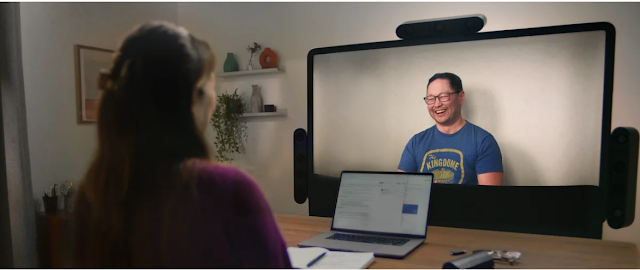Google's Project Starline: Revolutionizing Communication with 3D Video Conferencing
Have you ever wished you could talk to someone who is far away as if they were sitting right across from you? Imagine being able to see their facial expressions, gestures, and even the objects they are holding in 3D, without wearing any special glasses or headsets. That is the vision of Google's Project Starline, a prototype system that uses advanced cameras, sensors, and displays to create a lifelike 3D video chat experience.
Project Starline was first unveiled at Google I/O 2021, where the company showed a heartwarming video of family and friends reconnecting with each other using Starline booths. The participants were amazed by how realistic and immersive the experience was, and some even reached out to touch the screen as if they could feel the other person. "That was mindblowing," one person said. "I've seen a lot, but I've never seen this," said another.
But how does Project Starline work? According to Google, the system uses a combination of hardware and software technologies to capture, compress, transmit, and render a person's appearance in 3D. The system uses more than a dozen cameras and sensors to capture a person's shape, texture, motion, and lighting from multiple angles. Then, it uses custom-built compression techniques to stream the data over WebRTC, the same open-source infrastructure that powers Google Meet. Finally, it uses a special display that can show 3D images without requiring glasses or headsets.
The result is a "magic window" that makes you feel like you are in the same room with someone else, even if they are thousands of miles away. Google claims that Project Starline is not just 3D video conferencing, but a new form of communication that can convey emotions, nuances, and presence better than any existing technology.
However, Project Starline is still in its early stages of development and is not widely available yet. Google says it has been testing the system internally for over five years and has installed Starline booths in some of its offices around the world. The company also plans to partner with select enterprise customers later this year to test the system in different scenarios such as health care, education, and entertainment.
Google's ultimate goal is to make Project Starline accessible and affordable for everyone in the future. The company says it is working on improving the system's performance, quality, and reliability, as well as reducing its size and cost. Google also hopes to integrate Project Starline with its other products and services, such as Google Workspace, Gmail, and Photos.
Project Starline is one of Google's most ambitious and innovative projects yet. It shows the potential of 3D video conferencing to transform the way we communicate and connect with each other across distances. As Google's chief executive Sundar Pichai said at Google I/O 2021: "We believe this is where person-to-person communication technology can and should go."
Google's Project Starline has received encouraging feedback from its early access partners, including Salesforce, T-Mobile, and WeWork. The prototypes of this groundbreaking 3D video conferencing technology have been tested in real-world scenarios, specifically focusing on how Project Starline can facilitate seamless connectivity for distributed workforces. The initial results have been highly promising, demonstrating that Project Starline fosters stronger personal connections, alleviates meeting fatigue, and enhances attentiveness.
Read more about it here at - https://blog.google/technology/research/project-starline-prototype/












No comments: